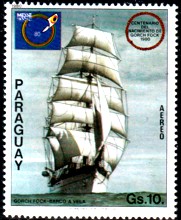
| Seemotive :
Die beiden Großsegler mit Namen 'Gorch Fock'.
|
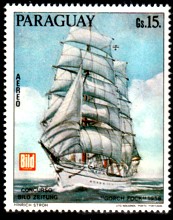
|
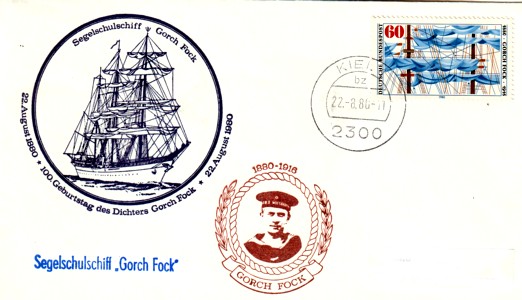
|
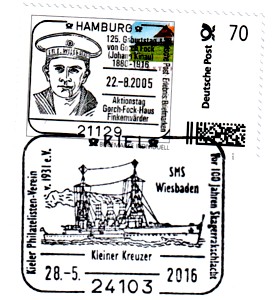
|
Gorch Fock, der eigentlich Johann Kinau hieß wurde 1880 in Hamburg Finkenwerder geboren.
Er wollte wie sein Vater Fischer werden, doch er war zu schmächtig dazu.
Er arbeitete als
Kaufmannsgehilfe und Buchhalter. Früh begann er Geschichten und Theaterstücke zu schreiben,
fast alle in Niederdeutscher Sprache.
1912 erschien sein Roman 'Seefahrt ist Not' der zu einem
Standardwerk der Seefahrtsliteratur wurde.
Dann sollte sein Seefahrtstraum tragisch in Erfüllung
gehen. Während des ersten Weltkrieges wurde er 1916 zur Marine einberufen.
Zwei Monate später ging er mit der SMS 'Wiesbaden' in der Schlacht am Skagerrak unter.
Bei der Deutschen Marine wurden bisher zwei Segelschulschiffe nach ihm benannt.
Auf dem obigen Umschlag sehen wir die zweite Bark mit Namen 'Gorch Fock' und die Marke
zum 100. Geburtstag des Dichters.
Links im Stempel die SMS "Wiesbaden".
|
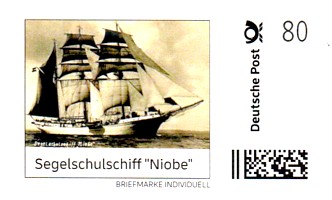
|
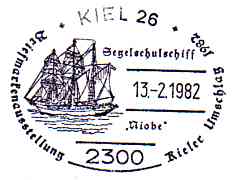
|
Am 26. Juli 1932 ging das deutsche Segelschulschiff 'Niobe' in der Ostsee bei der Insel Fehmarn unter.
In einer extrem starken Gewitterbö krängte der Gaffelschoner auf 40 bis 50 Grad, die Ruderwirkung
setzte aus.
Beim Versuch anzuluven legte sich die 'Niobe' völlig auf die Seite und kenterte innerhalb
weniger Minuten.
40 Mann konnten gerettet werden, 69 Seeleute ertranken weil unter Deck gerade ein
Unterricht stattfand.
Darauf beschloss die Reichsmarine ein neues Schulschiff zu bauen. Es bekam den Namen 'Gorch Fock'.
|
Die Daten der ersten 'Gorch Fock' :
- Baujahr 1933, Werft Blohm & Voss, Hamburg
- Typ Dreimastbark, Stahlrumpf
- Lüa x B x T = 82,1 * 12 * 5,2 Meter
- 1392 BRT, 1510 ts Verdrängung
- 23 Segel, insgesamt 1750 qm
- Höhe Großmast über Deck 41,3 Meter
- Hilfsmotor 550 PS
- 66 Mann Stammbesatzung, 180 Kadetten
bei der deutschen Reichsmarine
- 46 Mann Stammbesatzung, 150 Kursteilnehmer
als 'Tovarischtsch' bei der Sowjetunion
|
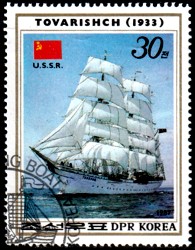
|
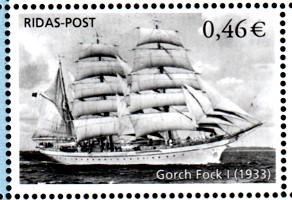
|
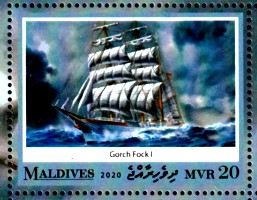
|
Bis 1939 machte die 'Gorch Fock' als Schulschiff ausgedehnte Ausbildungsreisen. Den zweiten
Weltkrieg überstand sie in Stralsund.
Als sie im Mai 1945 diesen Hafen verließ, lief sie
auf eine Mine und sank. Andere Quellen sprechen auch davon, dass sie 'versenkt wurde'.
1948 wurde
das Wrack von der Sowjetunion gehoben und drei Jahre repariert. 1951 folgte die Indienststellung
als Schulschiff der Handelsmarine der Sowjetunion unter dem Namen 'Tovarish' (Kamerad) auch 'Tovarishch' oder
'Towarischtsch' geschrieben.
Es wurde der Marineschule in Cherson am Schwarzen Meer übergeben.
Eigentlich ist es die 'Towarischtsch 2', denn die Russen hatten schon eine Viermastbark gleichen
Namens, die 1943 im Asowschen Meer untergegangen war.
|
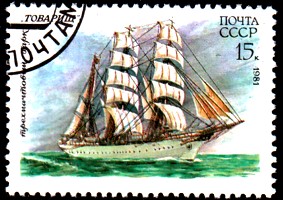
|
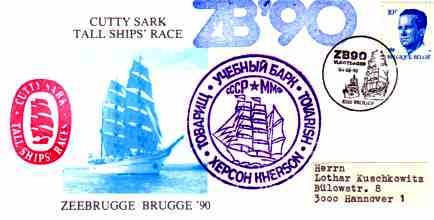
|
1957 fuhr die 'Towarischtsch' einmal um die Erde und rundete dabei Kap Horn. 1974 und 1976 siegte
sie zweimal bei den 'Operations Sail' Regatten.
1991 löste sich die Sowjetunion auf und die Bark
wechselte unter ukrainische Flagge, denn ihr Heimathafen Cherson gehört zur Ukraine.
Die deutsche 'Tall-Ship Friends' vermittelte 1992/93 Windjammerreisen auf der 'Towarischtsch'.
Von 1995 bis 1999 lag das Schiff zur Reparatur in England, doch die Arbeiten kamen nicht in Gang.
1999 bot 'Tall-Ship Friends' die Wiederinbetriebnahme an und das Schiff verholte nach Wilhelmshaven.
Im Jahre 2000 war die 'Towarischtsch' ein Highlight der 'EXPO am Meer'.
|
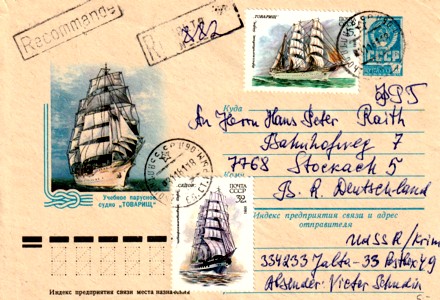
|
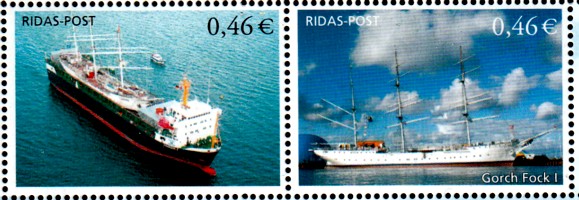
|
Die Ukraine hatte kein Geld für ihre 'Towarischtsch'. Der Liegeplatz war kostenlos und die
ukrainische Besatzung wurde von den Wilhelmshavenern durchgefüttert.
Vier Jahre lag der Segler so in Wilhelmshaven. 2003 gelang es 'Tall-Ship Friends' die Bark zu kaufen.
Die 'Towarischtsch' wurde mit dem Dockschiff 'Condock V' (Marke links) nach Stralsund gebracht
und dort reapariert.
Am 29. November 2003 wurde die Bark auf ihren alten Namen getauft: 'Gorch Fock'.
2004 begannen die Instandsetzungs- und Restaurierungsarbeiten. Ziel war es die Bark wieder unter Segeln
einsatzfähig zu machen.
2010 wurde die Fahrgenehmigung für die deutsche Ostsee beim Germanischen Lloyd angestrebt.
Allerdings fehlten für weitere Investitionen noch einige Millionen.
Im März 2016 wurde das Schiff in die Denkmalliste des Landes Mecklenburg-Vorpommern aufgenommen.
Es ist nun ein Museumsschiff, dass besichtigt werden kann.
|
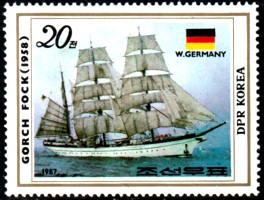
|
Die Daten der zweiten 'Gorch Fock' :
- Baujahr 1958, Werft Blohm & Voss, Hamburg
- Typ Dreimastbark, Stahlrumpf
- Lüa x B x T = 89,3 * 12 * 5 Meter
- 1760 ts Verdrängung
- 23 Segel, insgesamt 1952 qm
- Höhe Großmast über Wasserlinie 45,3 Meter
- Größte Rahlänge 24 Meter
- Hilfsmotor 800 PS, später 1.660 PS
- Geschwindigkeit unter Segel max. 16 kn,
unter Motor max. 13,7 kn
- 69 Mann Stammbesatzung, 200 Offiziers- und
Unteroffiziersanwärter
|
Die zweite 'Gorch Fock' hat vier Schwesterschiffe, die alle von 1933 bis 1938 bei Blohm und Voss gebaut
wurden.
Es sind die erste 'Gorch Fock' ex 'Towarischtsch', die 'Eagle' ex 'Horst Wessel', die
'Sagres II' ex 'Albert Leo Schlageter' und die 'Mircea'. Größtmögliche Sicherheit war
Forderung bei der Konstruktion dieser Schiffe und alle fahren heute noch!
Diese Vorkriegsbauten haben sich
so gut bewährt, dass bei der 'Gorch Fock' (2) nach den gleichen Konstruktionszeichnungen gebaut wurde.
|
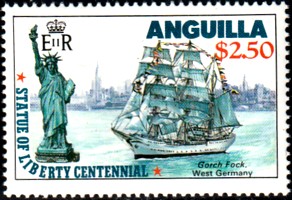
|
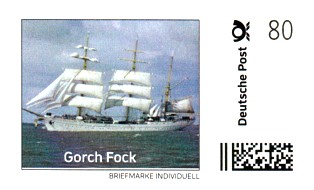
|
Bei der 'Gorch Fock' (2) sind Schiffsrumpf, Masten und Rahen aus Stahl.
Rund 300 Tonnen Eisenballast im Rumpf
geben dem Schiff eine gute Stabilität bis zur theoretischen 90 Grad Krängung.
Ein hohes Freibord und
zusätzliche Schotten sorgen weiter für Sicherheit gegen Wassereinbruch.
|
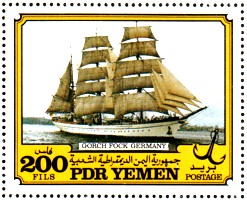
|
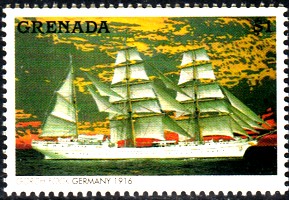
|
Die 'Gorch Fock' ist Segelschulschiff der Deutschen Marine. Offiziers- und Unteroffiziersanwärter
erhalten hier einen wichtigen Teil ihrer praktischen und theoretischen Ausbildung. Seit 1997 nehmen auch Frauen
daran teil.
Im Juli 1959 begann der erste Kurs, der mit einer Reise zu den Kanarischen Inseln seinen erfolgreichen
Abschluss fand.
Seitdem werden pro Jahr ca. drei Ausbildungsreisen gemacht. Im Winter liegt das Schiff oft in seinem
Heimathafen Kiel oder in einer Werft.
|
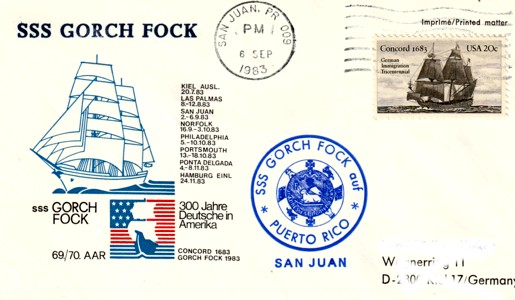
|
Inzwischen ist das Schiff schon über 50 Jahre im Dienst.
In dieser Zeit bis Ende 2008 wurden 151
Auslandsausbildungsreisen (AAR) erfolgreich absolviert.
Bei diesen AAR's wurden die Fahrtziele auch mit besonderen Anlässen gekoppelt. So z.B.
1983, als die Gorch Fock zur 300 Jahrfeier "Einwanderung der ersten Deutschen in Amerika"
nach Nordamerika segelte.
|
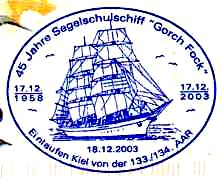
|
|
1987 / 88 segelte die 'Gorch Fock' in 336 Tagen einmal
rund um die Welt. Dabei wurden 33.572 sm zurückgelegt, 19 Häfen in 15 Ländern auf fünf
Kontinenten angelaufen (80. - 83. AAR).
1996/97 war die 'Gorch Fock' 343 Tage unterwegs und legte dabei rund 36.000 sm zurück, davon 65% unter Segel.
Bei diesen Reisen ist die 'Gorch Fock' Deutschlands diplomatischer Botschafter weltweit für Frieden,
Freundschaft und Verständigung zwischen den Völkern.
So nahm die 'Gorch Fock' 1976 an der 200-Jahr-Feier der amerikanischen
Unabhängigkeit in New York teil.
Sie segelte auch in der Parade bei der 200-Jahr-Feier zur Gründung der
australischen Nation 1988 in Sydney.
|
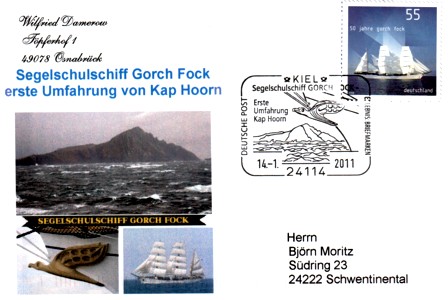
|
Bei ihrer Weltumrundung nutzte die "Gorch Fock" den Panamakanal.
Die Umsegelung von Cap Hoorn folgte
im Januar 2011.
|
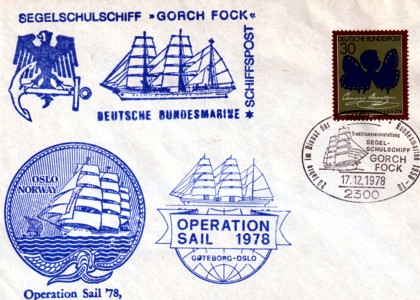
|
Seit 1960 nimmt die 'Gorch Fock' an internationalen Großseglertreffen und Regatten teil.
Das sind die jährlichen 'Cutty Sark Tall Ship Races', 'Operation Sail' und spezielle Regatten
wie z.B. 1992 die Columbus Regatta über den Atlantik. Dabei hat die Bark immer einen der vordersten
Plätze erreicht, acht mal war sie schnellstes Schiff im Zielhafen.
Das beste Wachetmal (gesegelte Distanz in vier Stunden) betrug 61,6 sm; das entspricht einer
Durchschnittsfahrt von 15,4 kn.
Das beste Tagesetmal lag bei 323,2 sm, das sind 13,4 kn im Schnitt.
|
Nach der Indienststellung 1958 übernahm die Hansestadt Hamburg die Patenschaft für die
'Gorch Fock'.
1982 folgte der Schleswig-Holsteinische Landtag mit einer weiteren Patenschaft /
Partnerschaft. Die 'Gorch Fock' hat sich bei zahlreichen Besuchen bei den Hamburger Hafengeburtstagen
beteiligt.
Und in ihrem Heimathafen Kiel führt sie stets die Windjammerparaden bei der
Kieler Woche als Flaggschiff an.
|
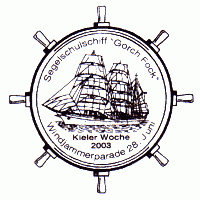
|
l
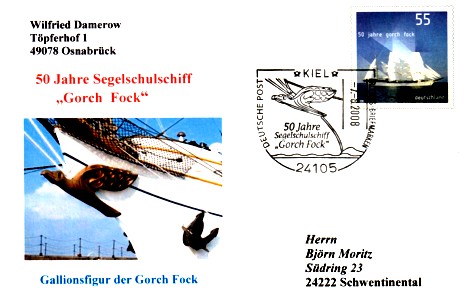
|
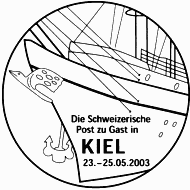
|
Auf diesem Brief und im Stempel sehen wir die Gallionsfigur der 'Gorch Fock', einen Albatros.
Insgesamt befindet sich heute (2021) bereits der 6. Albatros am Bug des Schiffes.
Der erste hölzernen Vogel riss ab, beim Zweiten bröckelte der goldene Anstrich, aus dem Dritten
lief rostiges Wasser, der Vierte verlor seinen Rumpf bei schwerer See im Ärmelkanal und der Fünfte
tauchte beim Sturm in der Biscaya unter.
Der sechste Albatros ist eine Figur aus Polyester mit einem inneren Verstärkungsrahmen und
hält schon über 10 Jahre.
|
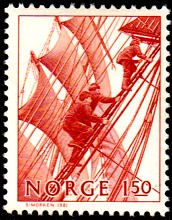
|
Insgesamt sind sechs schwere Unfälle an Bord der 'Gorch Fock' passiert, dabei fünf tödlich.
Bei einem Hafenaufenthalt in Brasilien im November 2010 stürzte eine junge Offiziersanwärterin
aus 27m Höhe aus dem Großmast auf das Deck und starb.
Darauf wurde der Ausbildungsbetrieb gestoppt. Eine Untersuchungskommission erschien, der Kommandant
wurde gefeuert. Die Medien stürzten sich auf das traurige Ereignis.
Von 2010 bis 2012 fand an Bord keine Ausbildung mehr statt.
|
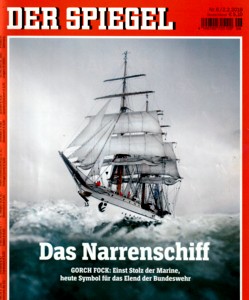
|
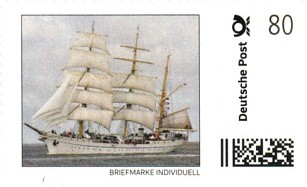
| |
Im Dezember 2015 wurde das Schiff zu einer vollständigen Grundinstandsetzung
an die Elsflether Werft übergeben.
Für die Instandsetzungsarbeiten hatte man zunächst 10 Millionen Euro kalkuliert.
|
Bei den begonnenen Arbeiten wurden im Januar 2016 weitere Schäden festgestellt,
woraufhin im Oktober 2016 ein Baustopp verhängt und eine Wirtschaftlichkeitsbetrachtung angewiesen wurde.
2017 entschied die Verteidigungsministerin die Instandsetzungsarbeiten fortzuführen.
Im Dezember 2018 kam es im Zusammenhang mit der 'Gorch Fock' zu Korruptions- und Untreuevorwürfen
gegen die Werft und einen Mitarbeiter der Marine.
Aufgrund der stark gestiegenen Kosten und des Korruptionsverdachts wurden
die Arbeiten am Schiff im Dezember 2018 vom Verteidigungsministerium ausgesetzt. 70 Millionen waren bereits gezahlt.
Man sprach von einem "Wirtschaftskrimi".
Die Kosten wurden nun mit 135 Mio Euro angegeben. Es wurde über einen Neubau diskutiert, doch man
entschied sich für den Fortgang der Instandsetzungsarbeiten.
Nachdem die Elsflether Werft Insolvenz anmelden musste, wurden die Arbeiten auf der Fassmer-Werft
und später auf der Lürssen-Werft fortgesetzt
Anfang 2021 sollte das Schiff an die Marine übergeben werden, doch der Termin wurde mehrfach verschoben.
Auch die ersten Testfahrten endeten mit Problemen, u.a. mit der Maschine.
Am 4. Oktober 2021 kehrte die "Gorch Fock" in ihren Heimathafen zurück, allerdings wurde noch emsig auf dem
Schiff gearbeitet.
Nun ist der Stahlrumpf fast komplett neu, die Masten sind neu und auch das Innenleben ist neu.
Von November 2021 bis zum März 2022 hat das Schiff die 171. Auslandsausbildungsreise (AAR) durchgeführt.
Duch diese extrem lange und total überteuerte Instandsetzung des Schiffes hat die Bundeswehr und
besonders die Marine an Ansehen und Glaubwürdigkeit gelitten.
Leider wurde auch der Name und die Person "Gorch Fock" beschädigt; dazu wurde die Bark als
Narrenschiff bezeichnet (siehe Bild links oben).
|
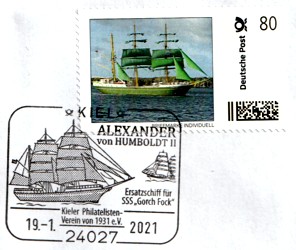
|
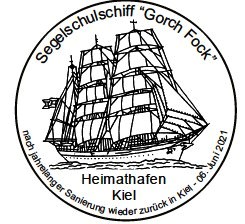
|
Während der extrem langen Werftliegezeit von 2015 bis 2021 ging die Ausbildung der Marine Offiziersanwärter
weiter.
Dazu wurden zwei Schiffe gechartert, die norwegische 'Statsrad Lehmkuhl' und die
'Alexander von Humboldt II'.
Im linken Stempel sehen wir " Alexander von Humboldt II Ersatzschiff für SSS Gorch Fock".
Im rechten Cachet steht "nach jahrelanger Sanierung wieder zurück in Kiel".
|
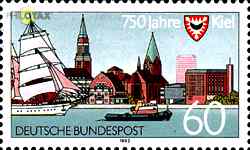
|
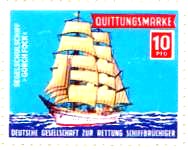
|
Links sehen wir das Vorschiff der 'Gorch Fock 2' in ihrem Heimathafen Kiel.
Die Deutsche Gesellschaft zur Rettung Schiffbrüchiger hat auch eine Quittungsmarke von der 'Gorch Fock 2'
herausgegeben.
|
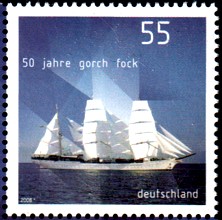
|
Zum 50jährigem Geburtstag der zweiten "Gorch Fock" hat die Deutsche Post 2008 nebenstehende Marke
herausgegeben.
Ein Bericht über die Schwesterschiffe 'Eagle' ex 'Horst Wessel', die 'Sagres II' ex 'Albert Leo Schlageter'
und die 'Mircea' sehen Sie auf der Seite:
Die Schwesterschiffe der 'Gorch Fock'.
|
Quelle:
Wikipedia Internet Enzyklopädie
Europäisches Segel-Informationssystem, 'Gorch Fock'
|
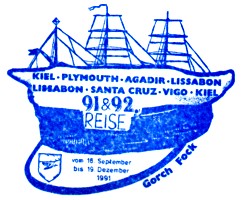
|
|
Hier folgen noch einige Sonderstempel, Bordstempel, Vignetten und Marken der "Gorch Fock". Davon sind
bereits mehr als 100 auf philatelistischen Belegen erschienen.
|
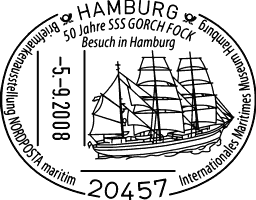
|
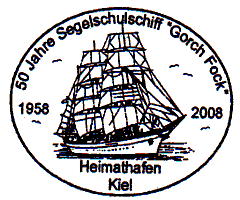
|
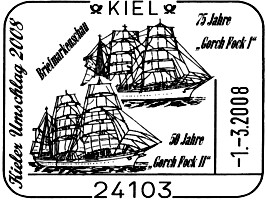
|
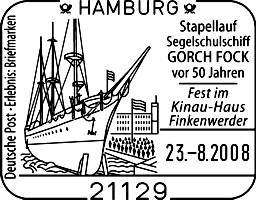
|
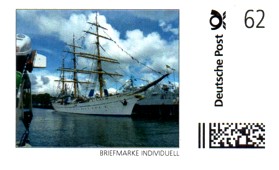
|
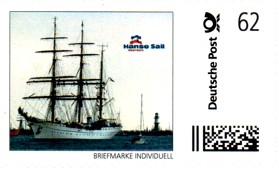
|
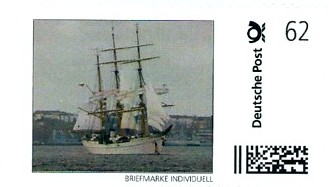
|
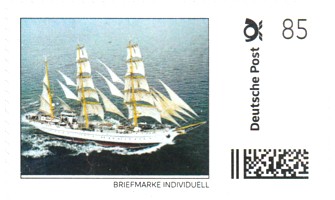
|
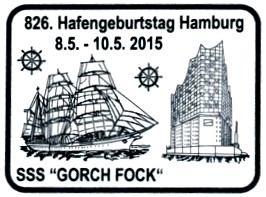
|

|
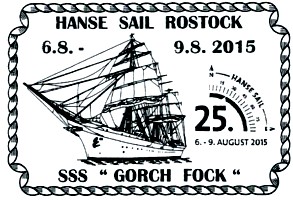
|
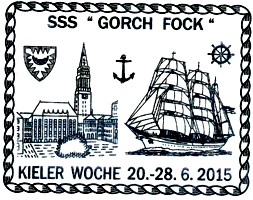
|
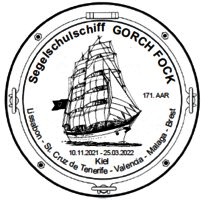
|
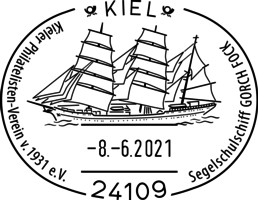
|
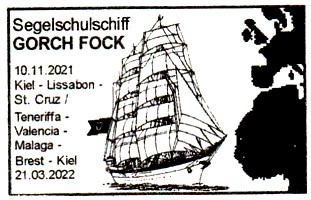
|
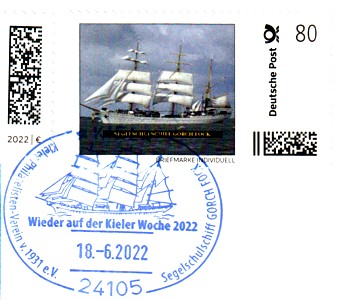
| |
Dies kann der Gorch Fock Sammler noch mit vielen weiteren Stempeln und Belegen fortsetzen.
|
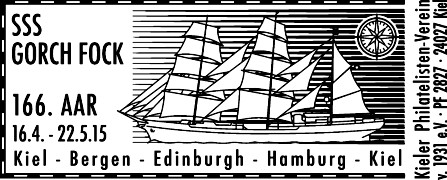
|
|